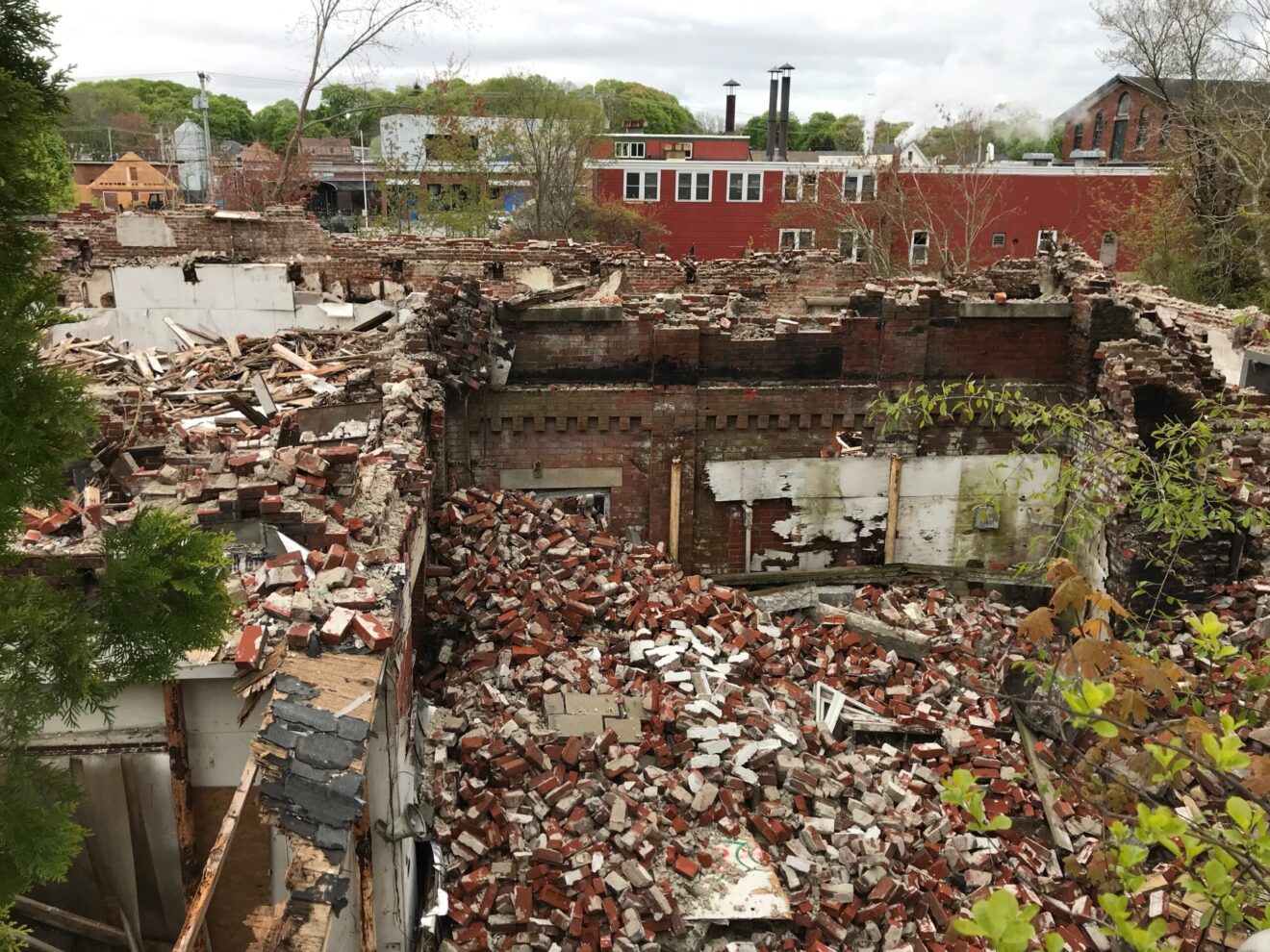STONINGTON — As arrangements for removing debris from the collapsed Stillmanville Mill proceed, the town is struggling to figure out how to recoup the costs for a project it never wanted.
The roof of the dilapidated mill, built in 1848, collapsed during a heavy rainstorm on April 15, causing debris to fall into the Pawcatuck River, which was federally designated a Wild and Scenic River on March 12. Located at 75 Stillman Ave. in Pawcatuck, the three-story brick building stood on a 1.2-acre site directly adjacent to the river, which provided hydropower for early operations as a textile mill.
The mill is owned by Pawcatuck Landing LLC and co-owned by L&M LLC, who purchased the building in 2006 for $270,000. The current owners have abandoned their claims of ownership and the property is considered abandoned, according to a town report dated April 4, 2019. The report also stated the taxes on the property were $7,724 in arrears and the Distressed Premises Citation fees, accruing at a rate of $100 per day, totaled $28,400.
“The town attorney has placed a lien on the property of $147,262 for the costs to the town thus far,” said First Selectman Rob Simmons at his office on May 14.
Even though the town doesn’t own the property, the building’s roof collapse engendered a public safety crisis that had to be addressed despite the costs, he said.
“The town is paying for the demolition and debris removal because we are confronted with a crisis where the owner of the building is not acting in a responsible fashion and has not been for some time and if we don’t take action, the crisis could become worse,” he said. “We will certainly put a lien on the property and we will seek some sort of assistance from federal and state entities for the remediation. We’ll go to our insurance company and see what options we have there to recover some of the costs of our actions.”
On April 24, the town’s Board of Finance approved separate emergency appropriations of $125,000 to cover the demolition costs and up to $600,000 for debris removal.
On a positive note, the debris removal is likely to cost less than $600,000, he said. For removing the debris in three weeks time, Wiese Construction Inc., of Norwich, bid $259,000 and Standard Demolition Services Inc., bid $327,300.
At the request of the Environmental Protection Agency, the town has hired Harley Langford, a senior environmental scientist with Tighe & Bond, an engineering and environmental consultancy in Middletown, to coordinate the removal of the contaminated material, which contains some polychlorinated biphenyl compounds (PCBs) and asbestos.
Since some of the bulk material may not be contaminated, sorting will be required before the debris can be removed from the site.
“We have to separate it out and based on the testing we have to send it to different locations. The bulk material ships for about $200 a ton, the contaminated material ships for about $400 a ton, and so we want to make sure the shipping of this material is done safely but also in an economically responsible way,” Simmons said.
Langford will supervise the contractors who are loading the trucks to make sure environmental procedures are followed. Workers will be required to wear coveralls, rubber gloves and eye protection. The site will be watered to keep the dust down and the tires of vehicles will be inspected and decontaminated as necessary.
Last year the state rejected the town’s application for a $200,000 brownfield state grant to assess the level of environmental contamination of the mill property, which last housed the Connecticut Investment Casting Corporation from 1961 and 1999 and has been vacant since.
In 2005 a private investor’s plan was approved to improve the mill structure and construct additional buildings to host 37 apartments, but the project was never executed. A 2006 study estimated site remediation at $1.1 million, which may have deterred investors. In April 2018, the town put the property up for a tax sale but no bidders came forward.
On Sept. 5, 2018, about 50 people from the mill’s neighborhood came to a town-organized community forum to discuss the future of the mill. The overwhelming consensus was to save the mill, but no investors appeared.
On the day of the roof collapse, a private investor named Tom Carter, who had been in touch with the town about purchasing the property, claimed he owned the building, according to town documents. He said had a viable plan for the property and asked the town to stabilize the mill rather the demolish it. However, it was discovered that even though Carter had a signed Purchase and Sale agreement, it had not been executed.
Looking back, Simmons said choosing to demolish the mill or to let it fall apart represented two impossible choices.
“What would you prefer, to spend $600,000 to avert further crisis, or would you prefer to sit and let the building fall in the river? It’s not a good choice either way,” he said.

